Understanding The Brisket Probe Method
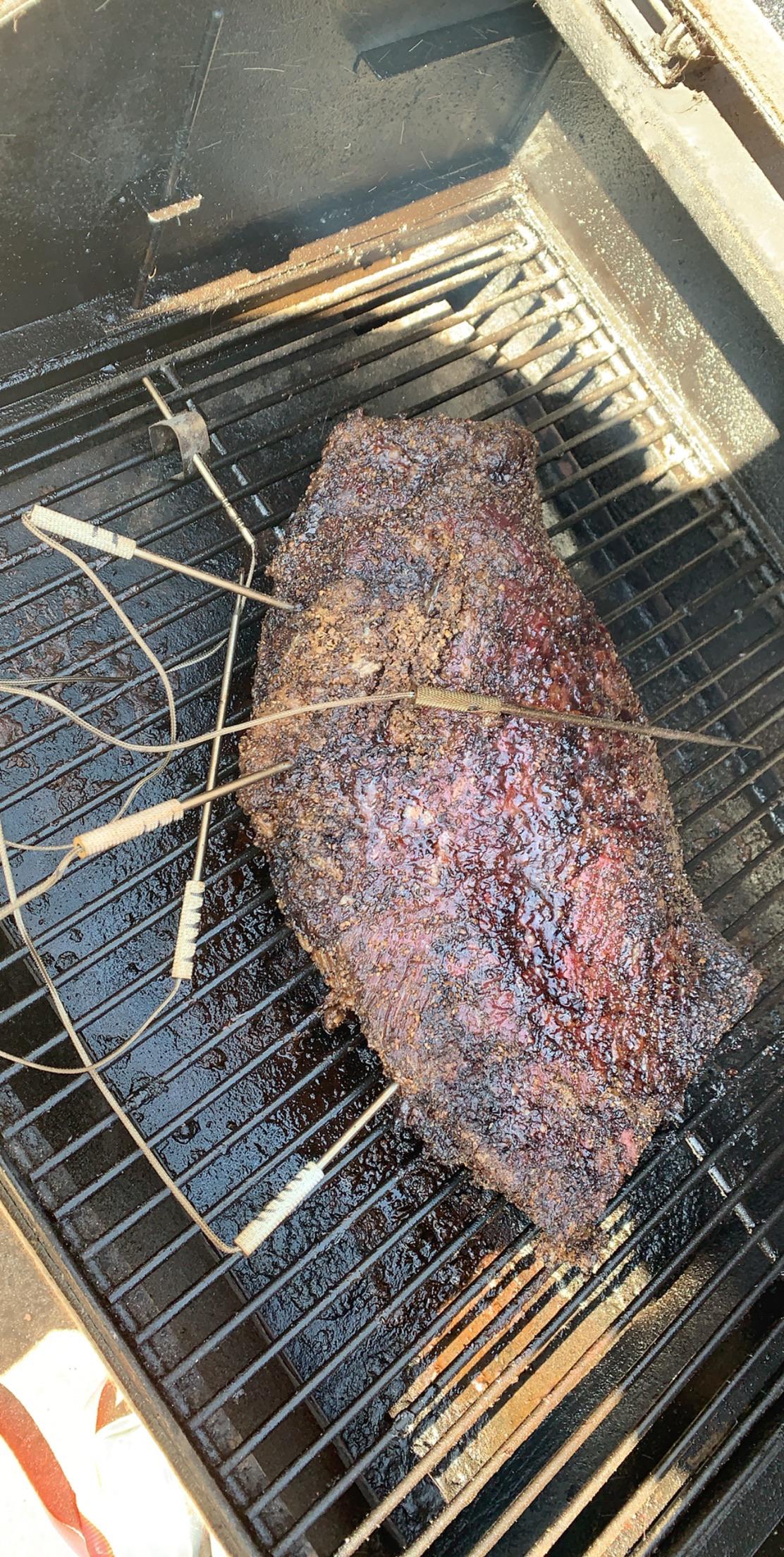
The brisket probe method is a crucial technique for achieving perfectly cooked brisket. By using a meat thermometer probe, you can accurately measure the internal temperature of the meat, ensuring that it is cooked to perfection. It is important to locate the thickest part of the brisket and insert the probe into the center, where the temperature is the coldest. Leaving the probe in allows you to monitor the temperature throughout the cooking process, ensuring that the brisket is cooked to your desired doneness. By understanding and using the brisket probe method, you can confidently cook a delicious brisket every time.
Importance Of Using A Probe To Determine The Perfect Brisket Temperature
Using a probe to determine the perfect brisket temperature is crucial for achieving a tender and juicy result. The probe allows for precise monitoring of the internal temperature, ensuring that the brisket is cooked to the desired level of doneness. This helps avoid the risk of undercooking or overcooking the meat, which can result in tough and dry brisket. By accurately measuring the temperature with a probe, you can ensure that the brisket is cooked to perfection, resulting in a flavorful and melt-in-your-mouth texture.
Different Types Of Meat Probes And Their Features
There are different types of meat probes available, each with its own features and benefits. Here are a few common types:
- Instant-read Probe: This probe gives quick temperature readings and is perfect for checking the doneness of individual steaks or small cuts of meat. It usually has a digital display and a thin probe for easy insertion.
- Leave-in Probe: These probes are designed to be inserted into the meat and left in throughout the cooking process. They are connected to a digital thermometer display outside the oven or grill, allowing you to monitor the temperature without opening the lid.
- Wireless Probe: This type of probe connects wirelessly to a base unit or smartphone app, allowing you to monitor the temperature from a distance. It is great for BBQ or slow-cooking, as you can check the temperature without constantly opening the grill or smoker.
- Bluetooth Probe: Similar to wireless probes, Bluetooth probes connect to a smartphone app through Bluetooth technology. They offer convenience and mobility, allowing you to monitor the temperature remotely.
When choosing a meat probe, consider factors like accuracy, durability, and ease of use. Some probes may also have additional features like preset temperature alarms or timers to enhance your cooking experience.
Brisket Probe Placement
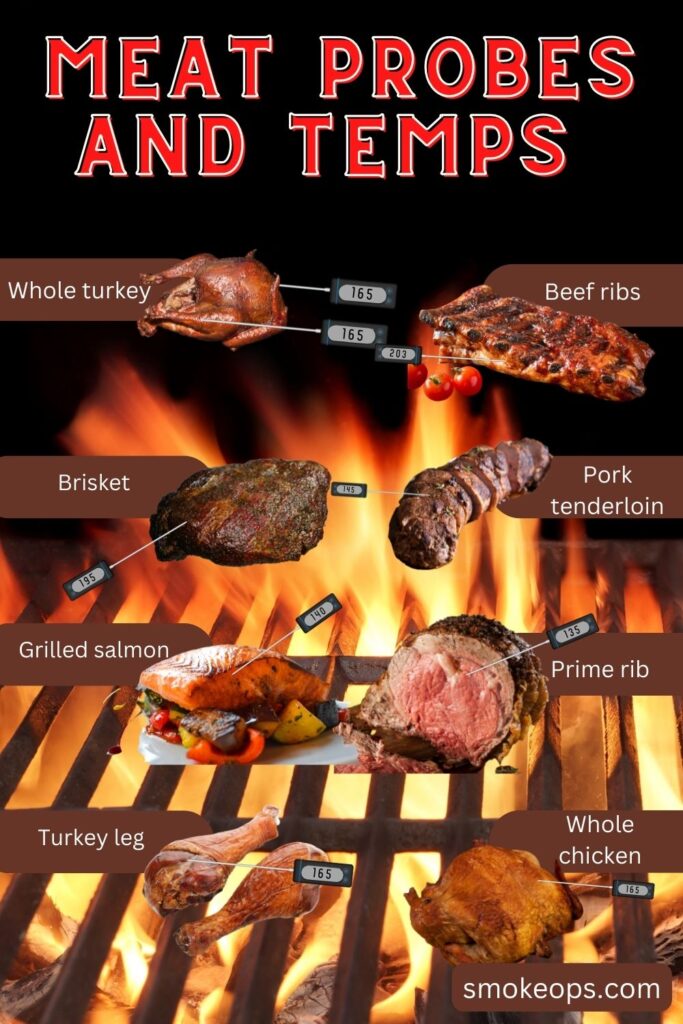
Proper placement of the meat probe is crucial for accurate temperature readings when cooking brisket. To ensure the most reliable results, aim for the thickest part of the cut, as this area cooks the slowest. Insert the probe all the way into the center of the brisket, where the internal temperature will be the coldest. By placing the probe in the right spot, you can monitor the meat’s temperature accurately throughout the cooking process, giving you the best chance of achieving the perfect brisket.
Identifying The Ideal Spots For Probing The Brisket
When it comes to identifying the ideal spots for probing a brisket, the goal is to find the thickest part of the meat. This is usually where the flat and point muscles meet, which is near the middle of the flat muscle. Insert the probe straight into this area, ensuring that it reaches the center of the brisket. By placing the probe in the thickest part, you will get the most accurate temperature reading and be able to monitor the doneness of the meat effectively. Remember to avoid touching any bones or fat pockets, as this can give false temperature readings.
Tips For Accurate Probe Placement
When aiming for accurate probe placement, there are a few tips to keep in mind. First, make sure to insert the probe straight into the thickest part of the brisket, where the flat and point muscles meet. This will ensure the most accurate temperature reading. Secondly, be cautious not to touch any bones or fat pockets, as this can give false temperature readings. Lastly, leave the probe in the brisket once it is inserted, as removing it and reinserting it can disturb the cooking process and lead to inaccurate readings.
Recommended Brisket Temperatures
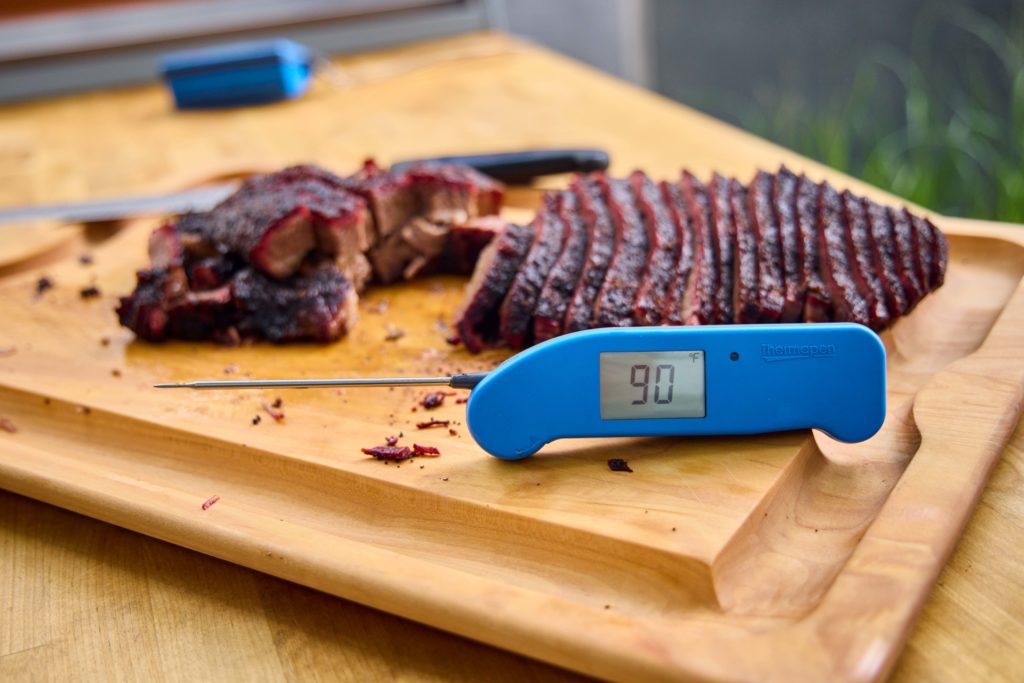
The recommended temperatures for cooking brisket can vary depending on the desired level of doneness. Here are some general guidelines to follow:
- Rare: Cook the brisket until it reaches an internal temperature of 130-135°F (54-57°C). The meat will be pink and juicy, with a tender texture.
- Medium-rare: Aim for an internal temperature of 140-145°F (60-63°C). This will result in a slightly firmer texture with a pink center.
- Medium: Cook the brisket to an internal temperature of 150-155°F (66-68°C). The meat will be more done with a hint of pink, offering a balance between tenderness and firmness.
- Well-done: For a well-done brisket, cook it until the internal temperature reaches 160°F (71°C) or higher. The meat will be fully cooked and tender throughout, without any pinkness.
Remember to account for carryover cooking, as the temperature of the brisket can continue to rise even after it is removed from the heat source. Use a reliable meat thermometer to ensure accuracy and achieve the desired level of doneness.
Desired Temperatures For Different Levels Of Doneness
The desired temperatures for different levels of doneness in brisket can vary depending on personal preference. Here are some general guidelines to follow:
- Rare: For a rare brisket, aim for an internal temperature of 130-135°F (54-57°C). The meat will be pink and juicy, with a tender texture.
- Medium-rare: Aim for an internal temperature of 140-145°F (60-63°C) for a medium-rare brisket. This will result in a slightly firmer texture with a pink center.
- Medium: Cook the brisket to an internal temperature of 150-155°F (66-68°C) for a medium doneness. The meat will be more done with a hint of pink, offering a balance between tenderness and firmness.
- Well-done: For a well-done brisket, cook it until the internal temperature reaches 160°F (71°C) or higher. The meat will be fully cooked and tender throughout, without any pinkness.
Remember to use a reliable meat thermometer to accurately monitor the brisket’s internal temperature and achieve the desired level of doneness.
Factors To Consider When Determining The Perfect Temperature
There are several factors to consider when determining the perfect temperature for your brisket. First and foremost, you need to consider your desired level of doneness. Different levels of doneness require different internal temperatures. Additionally, the size and thickness of the brisket will affect the cooking time and temperature needed. Furthermore, the cooking method you choose, such as smoking or grilling, may also impact the optimal temperature. Finally, personal preference plays a role, as some individuals prefer their brisket more tender and juicy, while others prefer it firmer and well-done. Consider these factors when determining the perfect temperature for your brisket.
Using A Meat Thermometer

Using a meat thermometer is essential for accurately determining the temperature of your brisket. To properly use a meat thermometer, insert the probe into the thickest part of the brisket without touching any bones or the cooking grate. Make sure the probe is inserted deep enough to reach the center of the meat. Leave the thermometer in place throughout the cooking process to monitor the temperature. There are various types of thermometers available, including instant-read, leave-in, and wireless thermometers, each with their own advantages and disadvantages. Choose the one that suits your needs and preferences to ensure your brisket is cooked to perfection.
How To Properly Use A Meat Thermometer For Brisket
To properly use a meat thermometer for brisket, follow these steps:
- Insert the probe into the thickest part of the brisket without touching any bones or the cooking grate.
- Ensure that the probe reaches the center of the meat for an accurate reading.
- Leave the thermometer in place throughout the cooking process to monitor the temperature.
- Check the temperature periodically to ensure the brisket is cooking evenly.
- Use a meat thermometer with a digital display for easy reading of the temperature.
- Remove the brisket from the heat when it reaches the desired internal temperature for your preferred level of doneness.
Following these steps will help you achieve perfectly cooked brisket every time.
Different Types Of Thermometers And Their Pros And Cons
There are several different types of thermometers that can be used when cooking brisket. Each type has its own pros and cons.
- Instant-read Thermometers: These thermometers provide a quick temperature reading and are easy to use. However, they are not designed to be left in the meat during cooking and can be less accurate than other types.
- Leave-in Probe Thermometers: These thermometers are designed to be inserted into the meat and left in place throughout the cooking process. They provide continuous temperature monitoring and can be more accurate. However, they may require calibration and can be more expensive.
- Wireless Thermometers: These thermometers consist of a probe that is inserted into the meat and a remote transmitter that allows you to monitor the temperature from a distance. They offer convenience and flexibility, but may have a shorter range and require batteries.
It is important to choose a thermometer that fits your needs and cooking style. Ultimately, the most important factor is accuracy and ensuring that you can monitor the temperature of the brisket effectively.
Common Mistakes In Probing Brisket
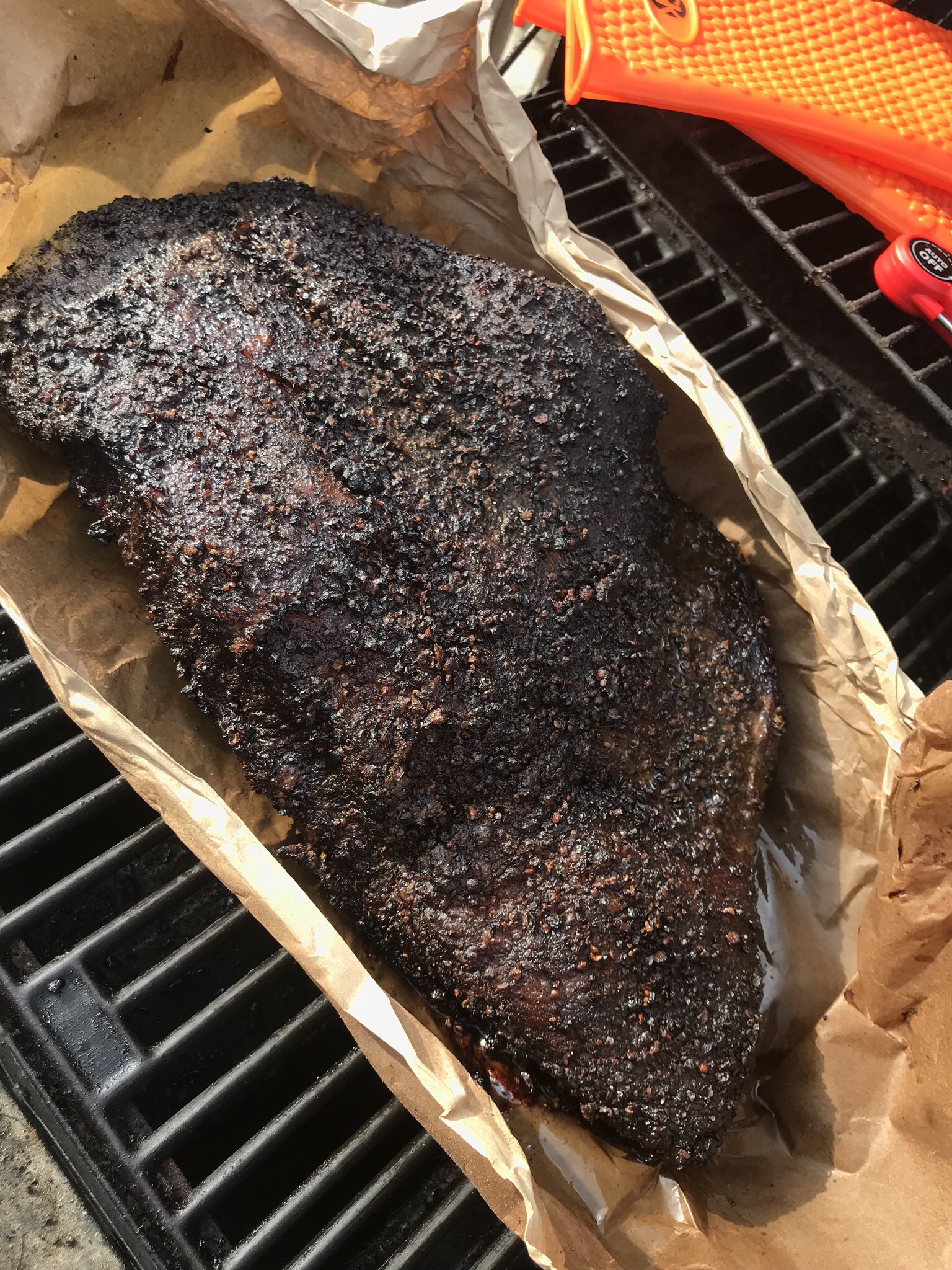
When it comes to probing brisket, there are some common mistakes that you should avoid to ensure accurate temperature readings. One of the biggest mistakes is placing the probe too close to the surface or bone, which can give false readings. Another mistake is not calibrating your thermometer before use, leading to inaccurate temperature readings. Additionally, removing the probe too soon or too late can result in over or undercooked brisket. It’s also important to avoid touching the bone with the probe, as it can give inaccurate temperature readings. By avoiding these common mistakes, you can ensure that your brisket is cooked to perfection.
Pitfalls To Avoid When Using A Thermometer Probe
When using a thermometer probe to measure the temperature of your brisket, there are several pitfalls to avoid. First, make sure to place the probe in the thickest part of the flat, avoiding any bones or fat pockets. Secondly, avoid placing the probe too close to the surface or bone, as this can give false readings. Additionally, do not remove the probe too soon or too late, as this can result in over or undercooked brisket. Lastly, ensure that your thermometer is properly calibrated before use to ensure accurate temperature readings.
Ways To Prevent Over Or Undercooking The Brisket
To prevent over or undercooking the brisket, there are several key tips to keep in mind.
- Use a thermometer: A reliable and accurate meat thermometer is essential to ensure you achieve the perfect internal temperature.
- Monitor the temperature: Regularly check the internal temperature of the brisket to avoid over or undercooking. This will help you make any necessary adjustments during the cooking process.
- Rest the brisket: After cooking, allow the brisket to rest for at least 15-20 minutes before slicing. This resting period helps redistribute the juices and ensures a moist and tender final product.
- Practice patience: Cooking brisket is a slow and low process, so be patient and avoid rushing the cooking time. Slow and steady cooking will yield the best results.
- Learn from experience: Each brisket is unique, so pay attention to the cooking process and make note of any adjustments you may need to make in the future to achieve your desired level of doneness.
By following these tips, you can avoid over or undercooking your brisket and enjoy a perfectly cooked, flavorful meal.
Conclusion And Probing Tips
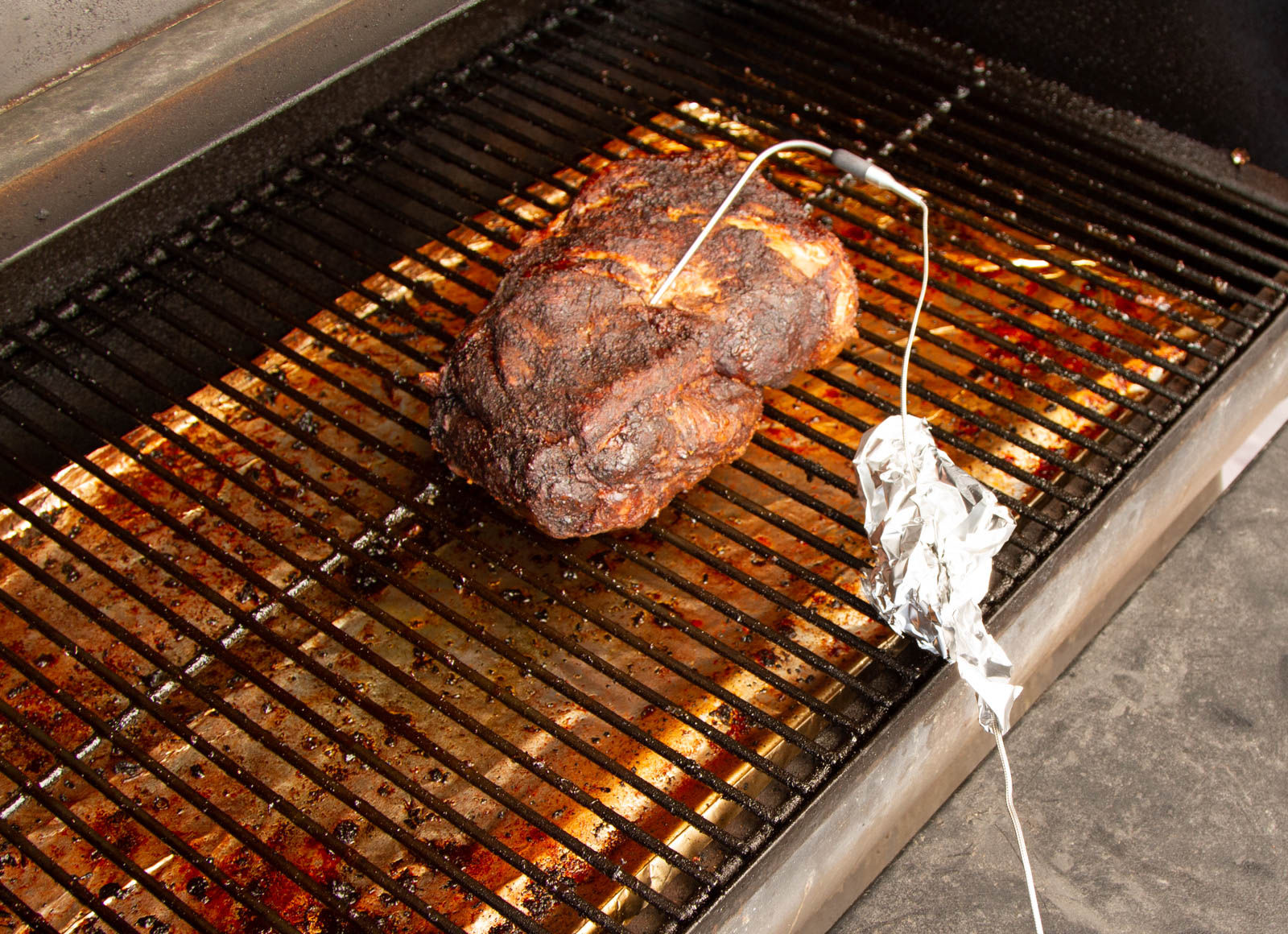
In conclusion, using a probe to determine the perfect temperature for your brisket is essential for achieving delicious results. By properly placing the probe in the thickest part of the meat and monitoring the temperature closely, you can ensure that your brisket is cooked to perfection. Remember to use a reliable meat thermometer and avoid common mistakes such as overcooking or undercooking the brisket. With practice and patience, you will master the art of probing brisket and create mouthwatering dishes every time.
Recap Of The Importance Of Proper Probing Techniques
Proper probing techniques are vital for achieving the perfect temperature for your brisket. By placing the probe in the thickest part of the meat, you ensure that it reaches the ideal doneness. This prevents overcooking or undercooking, resulting in a juicy and flavorful brisket. Using a reliable meat thermometer allows you to monitor the temperature accurately and make adjustments if needed. Remember to avoid common mistakes such as probing too close to the bone or relying solely on visual cues. Mastering proper probing techniques will elevate your brisket cooking to a whole new level.
Additional Tips And Guidelines For Achieving The Perfect Brisket Temperature
- Allow for a rest period: After removing the brisket from the smoker or oven, let it rest for about 15-30 minutes. This allows the juices to redistribute and results in a more tender and flavorful brisket.
- Use a digital thermometer: Invest in a reliable digital meat thermometer to accurately measure the internal temperature of the brisket. This ensures precise readings and helps you avoid over or undercooking.
- Consider the carryover cooking: Remember that the temperature of the brisket will continue to rise even after it’s been removed from the heat source. Account for this carryover cooking by removing the brisket from the heat when it’s a few degrees below your desired final temperature.
- Check multiple spots: To ensure an even cook, probe the brisket in multiple spots to check for consistency. The different parts of the brisket may cook at slightly different rates, so it’s important to check several areas for doneness.
- Practice patience: Achieving the perfect brisket temperature takes time and patience. Cook the brisket at a low and steady temperature, and resist the temptation to rush the process. Slow cooking results in a tender and flavorful brisket.
- Experiment and learn from experience: Every brisket is different, and it may take a few tries to find the perfect temperature and cooking time for your preferences. Keep track of your cooking results, take notes, and make adjustments based on your past experiences.
Remember, achieving the perfect brisket temperature is a combination of proper probing techniques, temperature monitoring, and experience. With practice and attention to detail, you’ll be able to consistently cook a delicious and tender brisket.
Frequently Asked Questions about Where to Probe Brisket
Q: Why is it important to probe brisket?
A: Probing brisket during the cooking process allows you to monitor its internal temperature, which is crucial to achieving the desired level of tenderness and doneness. It helps ensure that your brisket is cooked to perfection and safe to eat.
Q: Where should I probe the brisket?
A: The ideal spot to probe a brisket is in the thickest part of the meat, specifically the center of the flat portion. This location gives you the most accurate reading of the overall internal temperature of the brisket.
Q: What tool should I use to probe the brisket?
A: To probe the brisket, you can use a digital meat thermometer with a probe attached to a long wire. This allows you to monitor the internal temperature of the meat without needing to open the oven or smoker frequently.
Q: What temperature should I aim for when probing a brisket?
A: The desired temperature of a properly cooked brisket can vary depending on personal preference, but a common guideline is to aim for an internal temperature of 195 to 205°F (90 to 96°C). This range ensures that the brisket is tender, moist, and easily pull apart.
Q: Can I probe the brisket too early or too often?
A: It is essential to avoid probing the brisket too often as each time you open the oven or smoker, heat escapes and the cooking process slows down. Furthermore, early probing may not provide accurate readings since the brisket needs time to cook through. Aim to probe the brisket towards the end of the estimated cooking time or when it appears to be nearing completion.
Q: Should I only rely on the internal temperature when determining doneness?
A: While internal temperature is a crucial factor, it’s not the only indicator of doneness. Along with the temperature, you can also check the tenderness of the brisket by gently prodding it with a fork or meat probe. Additionally, a visual inspection of the meat’s color and texture can also provide useful information.
Q: What should I do if the brisket is not reaching the desired internal temperature?
A: If your brisket is taking longer than expected to reach the desired internal temperature, you can continue cooking it at a lower temperature or wrap it tightly in foil to help speed up the process. Keep in mind that cooking times can vary depending on various factors like the size of the brisket and the cooking method used.
Q: How long should I let the brisket rest after probing?
A: After probing the brisket and determining it is fully cooked, it is crucial to allow it to rest. This resting period allows the meat to reabsorb the juices, resulting in a more flavorful and tender brisket. Let the brisket rest, tented with foil, for 15 to 30 minutes before slicing and serving.
Remember, probing your brisket at the right time and in the right spot is key to achieving a delicious and perfectly cooked brisket. Enjoy the process and savor the mouthwatering results!
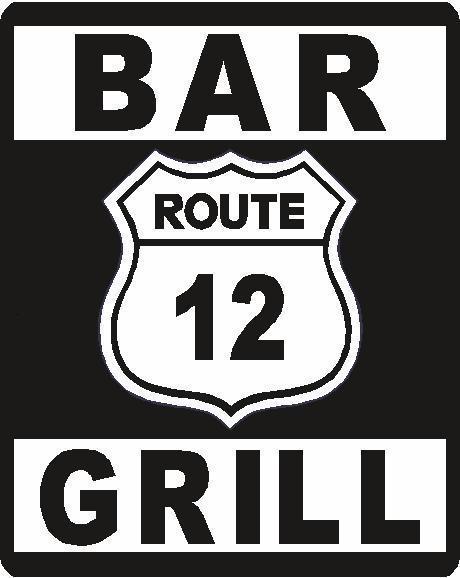
Come for The Burgers… Stay for The Beers!